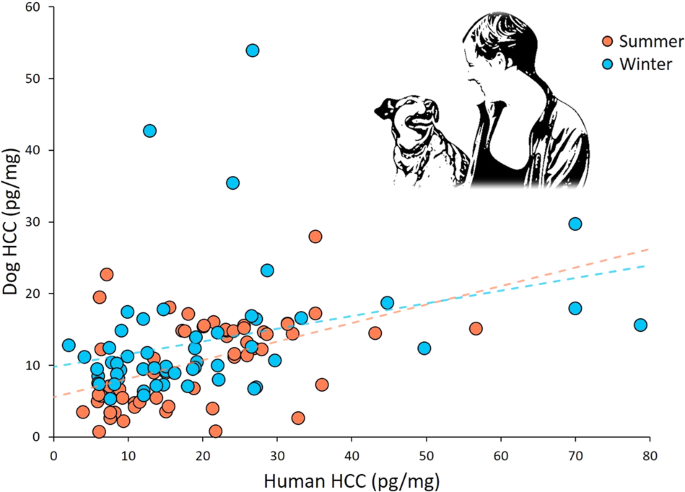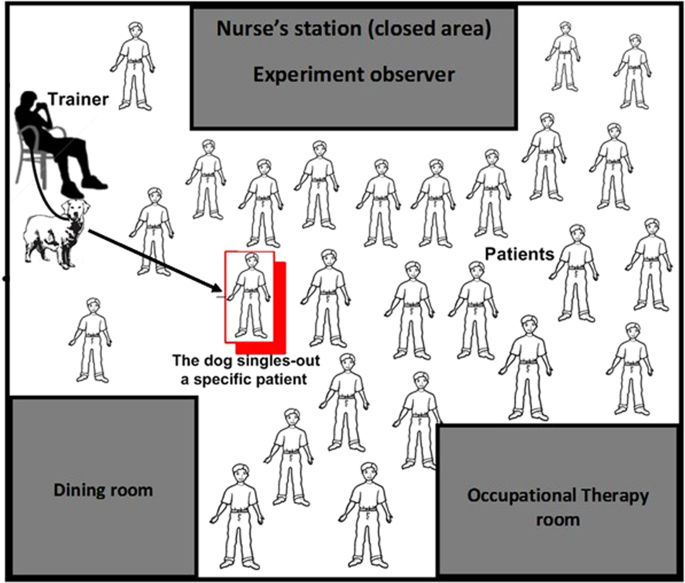Something that I became more acutely aware of with my last dog - my emotional state definitely impacted hers. If she started acting out, I learned to check in with myself.
The full paper:

 www.nature.com
www.nature.com
Discussion
Through assessment of cortisol concentration in hair of both dogs and their owners, we found an interspecific long-term stress hormone synchronization within the dog-human dyad (Fig. 5). This was observed in two different seasons within one year and was not related to the dogs’ physical activity level. There was also a seasonal effect, and dog HCC was higher during the winter months. Additionally, we show that owner’s personality rather than dog’s personality affects HCC, and therefore suggest that dogs mirror the stress of their owners. Our results are the first demonstration of a long-term synchronization in stress levels between members of two different species.
The evidence of short-term stress contagion within a species is compelling5 and Buttner, et al.9 shows that there is also a cortisol synchronization between species, namely between handlers and their dogs during agility competition. However, this can partly be caused by the mutual physical activity during such a competition and does not necessarily reflect contagious effects of psychological stress. Here, we found synchronized long-term stress levels in dog-human dyads, containing both pet and competing dogs of two different dog breeds, providing further evidence to the strong relationship between humans and dogs. Long-term stress contagion has previously been shown between human mothers and both their infants13 and their older children12. However, this is the first study on long-term interspecies stress synchronization.
While there was a synchronization for all tested groups of dogs, the synchrony was affected by sex and lifestyle. The HCC of both male and female dogs was synchronized with owner HCC, but the association was stronger in female dogs. Furthermore, in general, female dogs showed a higher cortisol concentration than male dogs. Indeed, studies on other species have previously suggested that, compared to males, females show a higher emotional responsivity. This is found in humans19, chimpanzees20, and rats21, and it has been suggested that the ultimate cause is the different social roles of males and females22. Within the human-dog dyad, oxytocin administration in dogs has a pronounced effect on female dogs’ interaction with their owner, and, in addition, an increase in owner oxytocin concentration, but there is no similar effect in males23. Thus, both our results and those of Nagasawa, et al.23 show that dogs’ sex affects hormonal synchronization.
The interaction between lifestyle and human HCC on dog HCC suggests a stronger association in cortisol synchronization among competing dyads than among pet dyads. It may be that competing owners and their dogs spend more time together engaging in the same tasks. Indeed, training may increase emotional closeness as earlier suggested by Meyer and Forkman16 and thereby generate a stronger synchronization. Similarly, Roth, et al.15 found that competing dogs have higher HCC than other dogs. Of course, the difference between competing and pet dogs may not only be the lifestyle in itself, they may also differ in traits not covered within the scope of this study. Certain traits may make a dog more suitable for canine sports that may also affect the stress response.
The HCC could not be related to the dogs’ physical activity obtained by smart collars or the training frequency reported by the owners. We did, however, find characteristics that significantly affected dog HCC. Interestingly, we show that owner personality, or more specifically, the traits Neuroticism, Openness and Conscientiousness, influence long-term cortisol concentrations in the dog. Both Kotrschal, et al.24 and Schöberl, et al.17 found that cortisol concentration in morning saliva is lower in dogs with more owners scoring high on Neuroticism. This is in line with our results, and owners that scored high on Neuroticism also had dogs with low HCC. There is some indication that humans scoring high on Neuroticism form a strong attachment bond to their dogs and that these individuals, to a greater extent than others, use their dog as a social supporter whilst also simultaneously functioning as a social supporter for their dog24. This, in turn, may lead to a positive modulation of the stress response for both parties.
We also found a positive association between dog HCC and scores on both Openness and Conscientiousness in the owners, but whereas Neuroticism affected HCC from both sampling occasions, Openness and Conscientiousness only had an effect on winter samples. Additionally, similarly to what was reported by Roth, et al.15, there was a seasonal effect on dog HCC and cortisol was higher during the winter months. This was significant for the Shetland sheepdogs but not for the border collies. It could be speculated that some dogs are more affected by cold winter temperatures, but future studies will need to disentangle seasonal effects to reveal possible causations.
There were significant interactions between personality traits and sex, where HCC in male and female dogs was differently affected by owner personality. Schöberl, et al.17 found that owner cortisol was lower in women owning male dogs. We only included female owners, but our results are still in line with this observation. Contrary to owner personality, dog personality traits had little effect on dog HCC and consistent with previous studies there was no significant correlations between short-term cortisol concentrations and dog personality17,25,26.
Questionnaires are at a risk of being biased by the person completing them and, in this study, both dog and owner personality surveys were completed by the same person. However, both surveys have been validated and the questions are formulated differently in the two, hence, it is unlikely that answering one questionnaire has influenced the owner when completing the other.
The facts that we observe synchronization between dog and human cortisol concentrations and that characteristics of the owner rather than those of the dog are related to dog cortisol levels, make us suggest that it is the dogs that mirror the stress levels of their owners rather than the opposite. This may be relevant from the perspective of the welfare of dogs since stress and related health issues are of great concern in today’s human society. From the human’s point of view, the dog is an important social supporter, has positive effects on learning ability and several health aspects24,27,28,29. From the dog’s point of view, there are indeed several positive effects of the human-dog interaction30,31, but our results suggest human-dog matches may be important for the stress levels of dogs.
Conclusion
Our results show that long-term stress hormone levels were synchronized between dogs and humans, two different species sharing everyday life. This could not be explained by either physical activity or by the amount of training. Since the personality of the owners was significantly related to the HCC of their dogs, we suggest that it is the dogs that mirror the stress levels of their owners rather than the owners responding to the stress in their dogs. To our knowledge, this is the first study to show interspecies synchronization of long-term stress.
The full paper:

Long-term stress levels are synchronized in dogs and their owners - Scientific Reports
This study reveals, for the first time, an interspecific synchronization in long-term stress levels. Previously, acute stress, has been shown to be highly contagious both among humans and between individuals of other species. Here, long-term stress synchronization in dogs and their owners was...


